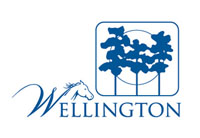Members of the Wellington Village Council met with Equestrian Preserve Committee members last week to discuss progress on the village’s equestrian master plan.
Wellington has been working on a new master plan to address equestrian issues since 2011, when it hired Florida Atlantic University to survey equestrian and non-equestrian residents alike and get a feel for the needs of the community.
At the Dec. 12 meeting, Dr. Jaap Vos, who has been working with the village through the FAU partnership, said that the survey data shows that the equestrian community is largely in agreement on many issues.
“There is agreement that Wellington is indeed one of the best equestrian areas in the world,” he said. “It seems people agree that a mix of equestrian disciplines is one of the things that makes this place very unique and desirable.”
During focus groups following the surveys, Vos said that the community stressed that Wellington must put the horses first in drafting its new regulations and future plans. “It’s clear that the horse needs to be central in any equestrian master plan,” he said.
Of the improvements desired in the area, Vos said equestrians overwhelmingly asked for more and better bridle paths and road crossings. “They want a safe way to move through Wellington,” he said.
Village Manager Paul Schofield said that one of the largest safety problems is when horses and cars clash. “One of the things people stress is to keep horses away from cars,” he said.
Schofield said that doing things like delineating horse crossings at intersections is fairly easy, but restructuring the bridle trail system for safety would be harder. “It is a more difficult thing to do to take the trail system that is out there and get something that is there and safe,” he said.
Councilwoman Anne Gerwig wanted to know whether a horse overpass was feasible at the intersection of Pierson Road and South Shore Blvd. “Is it just way too difficult to achieve?” she asked.
Equestrian Master Plan Project Director Mike O’Dell said that Wellington has looked at the issue.
“There are a number of different plans out there that have looked at the concept of putting an overpass there in some format,” he said. “I think if you put some good engineering minds together, you could come up with something that works.”
The one issue where the community was split, Vos said, was on increasing commercial development in the equestrian area, with 42 percent against it and 37 percent in favor.
“One of the issues with this question is that commercial development means different things to different people,” he said. “The community is clearly divided about this.”
Gerwig asked whether equestrian venues were considered commercial elements. “Some people would consider them a purely horse or recreational element,” she said. “That’s not clear from the question.”
Vos said it was open to interpretation, but said he found that all other questions, which were equally vague, typically resulted in consensus among their answers.
“This survey was done at a difficult time; there was major controversy,” he said. “It’s surprising that people agreed on most of the issues.”
Equestrian Preserve Committee Chair Cynthia Gardner noted that in the past 12 years, the equestrian community has fought against development in several areas, including property near Lake Worth Road and South Shore Blvd. and at the Equestrian Village site.
“The equestrian community has spent the last 12 years fighting commercial development,” she said. “To people who have been fighting and have friends who don’t live here anymore because of the growth that was threatened, there are seriously critical issues.”
One area where Vos said data had been inconclusive was in the economic impact of the equestrian community to Wellington. He noted that a 2011 study by the Palm Beach County Sports Commission found the industry had a $185 million impact countywide, but he added that it could not be known how much stays in the village.
“We really don’t have any data on that,” he said. “We’re not sure how much of it contributes to the local economy in Wellington.”
He said that FAU evaluated Wellington’s employment structure compared with those of other communities, such as Royal Palm Beach and Coral Springs, and found little difference.
“It was surprising,” Vos said. “Here we have an industry with a $185 million impact on the economy. Why don’t we see that?”
He said it’s possible the study did not test for the right variables, but suggested Wellington look into how it “captures the economic benefit” brought in by the industry.
After three hours of tackling issues from public riding spaces to commercial development, Equestrian Preserve Committee members expected to use the information and opinions to help draft the master plan before it returns to the council.
“That was the way the council set up the process, so that it would be in the hands of the committee,” Schofield said. “That’s really how it should be.”








